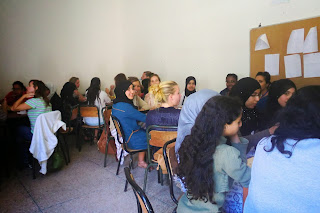“Because they [Chikhates] blur the boundaries between ordinary and extraordinary experience, between private and public genres of expressions, they become the social representatives of transgression.” --Deborah Kapchan, Gender on the Market: Moroccan Women and the Revoicing of Tradition, 1996
This past week we conducted our very first film screening at Dar Si Hmad as part of our monthly Film Education Program. We organized the event and invited students from Ibn Zohr University and other institutions to attend. We chose a unique documentary film titled Les Blues des Chikhates directed by Ali Essafi in 2005. The film illustrates the story of three Chikhates of different generations: Ayda, Aicha and Hafida. In Moroccan society, Chikhates are popular female dancers and singers who are true artists and rebels at heart. Historically Chikhates have been marginalized figures with a heavy reputation as being immoral, having their art be pushed aside while their harsh image persists. The narrative raises questions about the Chikhates’ status and gender politics in Moroccan society, and the relationship Chikhates have with one another.
This documentary was released by the Arab Film Distribution as part of a film series called Women Pioneers Collection. Ali Essafi, the film’s director, was born in 1963 in Fes, Morocco and left to France to study Psychology. He started his cinematic career as an assistant to various filmmakers. He directed many documentaries such as Ouarzazate Movie, Wanted, and Al Jazeera, la nouvelle voix des Arabes. He worked as an adviser to one of the Moroccan public television channels for three years. Ali Essafi is one of the pioneers of documentary film making in Morocco.
After the screening we facilitated a discussion about the documentary. We discussed the Chikhates as being marginalized women in Moroccan society, due to their trespassing of the patriarchal norms. One student from the audience stated that “our society is a hypocritical one in terms of dealing with this category of women; people love Chikhates’ music yet despise them and frown upon them.” Others had completely different opinions. For instance, one of the students claimed that Chikha is the one responsible for the “bad” image people have about her because she smokes cigarettes, drinks alcohol, and goes out late at night. Another student argued that these women are rebellious figures in Moroccan history and we should be proud of them. We discussed notions such as public and private spaces and consequences that one must deal with when trespassing a society’s boundary. Another student stressed that though Chikhates are not respected, they still represent various aspects of Moroccan history and culture. Thanks to this documentary, the students reflected on such issues in their own society.















